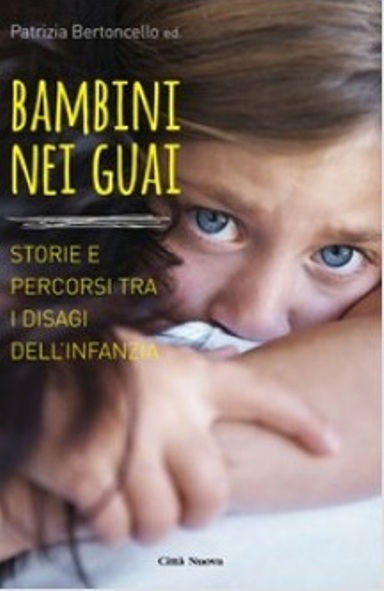 “A long stint as a primary school teacher – book curator, Patrizia Bertoncello, starts – soon led me to perceive those typical signs of distress which are more present in the peripheries than elsewhere. Often the children themselves talked about it. “Once upon a time there was a flower – Cristina, seven years old, wrote in class – her daddy-flower had left them and also mother-flower was not with him since she had so much to do and was very worried. She didn’t have time to listen to him. The flower was a rose with a thousand thorns. There were so many and pricked so much. The flower wanted to befriend the insects of the woods and the other flowers. But when they came close they got pricked so hard and ran away quickly, since she stung so much. And nothing could be done about it. In the end the rose was always alone and very sad.”(1) This is the lucid explanation she herself gave for those repeated pranks in class which isolated her from everyone. Like her, but with different problems, were the numerous children in distress, even in a world like ours that seems to be livable and protective, but not without contradictions and ambivalences weighing on the weaker sections of humanity. At times those institutions which in words advocate the rights of children, in fact, do little about it. Especially those children who cannot count on effective parents or long-lasting family relations are thus left in a sort of shadow zone, affective instability and often lacerating poverty. The lack of protection and real growth opportunities are conditions that certainly are not worthy of a society like ours. This is why I often asked myself how I could give a voice to these “invisible children,” and contribute to the building of a culture of protection and total respect for infancy.
“A long stint as a primary school teacher – book curator, Patrizia Bertoncello, starts – soon led me to perceive those typical signs of distress which are more present in the peripheries than elsewhere. Often the children themselves talked about it. “Once upon a time there was a flower – Cristina, seven years old, wrote in class – her daddy-flower had left them and also mother-flower was not with him since she had so much to do and was very worried. She didn’t have time to listen to him. The flower was a rose with a thousand thorns. There were so many and pricked so much. The flower wanted to befriend the insects of the woods and the other flowers. But when they came close they got pricked so hard and ran away quickly, since she stung so much. And nothing could be done about it. In the end the rose was always alone and very sad.”(1) This is the lucid explanation she herself gave for those repeated pranks in class which isolated her from everyone. Like her, but with different problems, were the numerous children in distress, even in a world like ours that seems to be livable and protective, but not without contradictions and ambivalences weighing on the weaker sections of humanity. At times those institutions which in words advocate the rights of children, in fact, do little about it. Especially those children who cannot count on effective parents or long-lasting family relations are thus left in a sort of shadow zone, affective instability and often lacerating poverty. The lack of protection and real growth opportunities are conditions that certainly are not worthy of a society like ours. This is why I often asked myself how I could give a voice to these “invisible children,” and contribute to the building of a culture of protection and total respect for infancy.  I started by trying to welcome some of my students with love, and slowly I saw that their tears dried up. I realised that to really “encounter” the world of the little ones, we have to approach each child with attention, and learn to see things through their eyes, making use of all our energies and skills to create important relationships. With other operators and professionals driven by the same educative style, I then tried to start up procedures in which the children and their families experience really educational relationships. From this cooperation the idea of a book came up, to narrate not only the stories of the “invisible children,” but also about good practices and redemptive pathways. “Children in Trouble,” said an oncologist, a social worker, a paediatrician and me, who curated the book, wants to bring out those seeds of hope and positive relations that become in some way, generators of resilience. Through that resource, many children when suitably aided are able to concretise and reach good recovery levels. The same happened to Emma. When she was eight years of age, overwhelmed by the split up of the family she had tried to commit suicide. Recently, after contacting me on Facebook, she wrote: “Dear teacher, how I miss you and the many moments we spent together! Do you remember when you read stories to us, taking on the voice of the characters? And the school trip to the sea? These will certainly never be erased from my heart and the love you showed me when all was dark around me. When I was in the hospital after the tragic event, you were there and didn’t ask me why I had done it. You were there, and that’s all. Then I returned to school with those wounds and you made everyone make those bracelets with coloured threads… but I knew that it was to help me hide those scars I didn’t want others to see…”(2) At the presentation of the book in universities and seminars, it was really surprising to see the attention and seriousness of the audience who started to take notice of that child next door, or the one who is begging in the subway or in a hospital ward. They were children who were invisible and now can return to being protagonists of their own future. By Anna Friso 1) – 2) – Patrizia Bertoncello – Bambini nei guai (Children in trouble) – Città Nuova Ed. 2015, p. 11 and p. 66
I started by trying to welcome some of my students with love, and slowly I saw that their tears dried up. I realised that to really “encounter” the world of the little ones, we have to approach each child with attention, and learn to see things through their eyes, making use of all our energies and skills to create important relationships. With other operators and professionals driven by the same educative style, I then tried to start up procedures in which the children and their families experience really educational relationships. From this cooperation the idea of a book came up, to narrate not only the stories of the “invisible children,” but also about good practices and redemptive pathways. “Children in Trouble,” said an oncologist, a social worker, a paediatrician and me, who curated the book, wants to bring out those seeds of hope and positive relations that become in some way, generators of resilience. Through that resource, many children when suitably aided are able to concretise and reach good recovery levels. The same happened to Emma. When she was eight years of age, overwhelmed by the split up of the family she had tried to commit suicide. Recently, after contacting me on Facebook, she wrote: “Dear teacher, how I miss you and the many moments we spent together! Do you remember when you read stories to us, taking on the voice of the characters? And the school trip to the sea? These will certainly never be erased from my heart and the love you showed me when all was dark around me. When I was in the hospital after the tragic event, you were there and didn’t ask me why I had done it. You were there, and that’s all. Then I returned to school with those wounds and you made everyone make those bracelets with coloured threads… but I knew that it was to help me hide those scars I didn’t want others to see…”(2) At the presentation of the book in universities and seminars, it was really surprising to see the attention and seriousness of the audience who started to take notice of that child next door, or the one who is begging in the subway or in a hospital ward. They were children who were invisible and now can return to being protagonists of their own future. By Anna Friso 1) – 2) – Patrizia Bertoncello – Bambini nei guai (Children in trouble) – Città Nuova Ed. 2015, p. 11 and p. 66
Yes to God
Yes to God




0 Comments